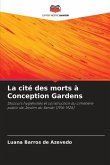In the second half of the 19th century, hygienist, urbanist and modern ideals were being established in Brazil, mainly coming from Europe. Entering the backlands of Rio Grande do Norte, we could find the village of Conceição do Azevedo, now Jardim do Seridó. It was in 1858 that the public cemetery was installed, which to this day can be seen as a space of cultural and social representation, through its various funeral monuments. By entering this memory space, we can understand the cultural configuration that describes a population, in its tones, its shapes, smells and descriptions. "The city of the dead in Jardim de Conceição" is a book that aims to discuss a little about the history of Jardim do Seridó through its public cemetery.








